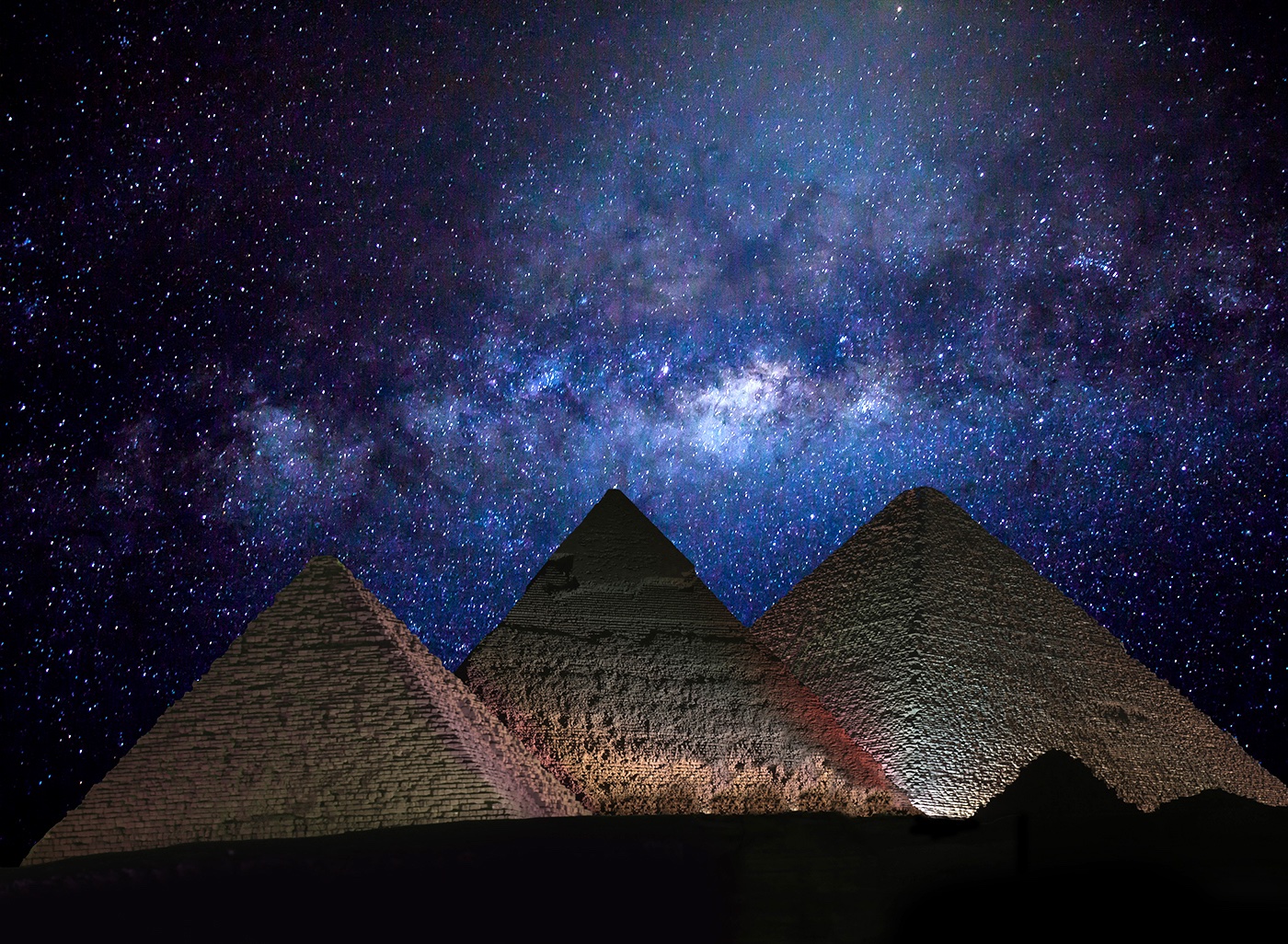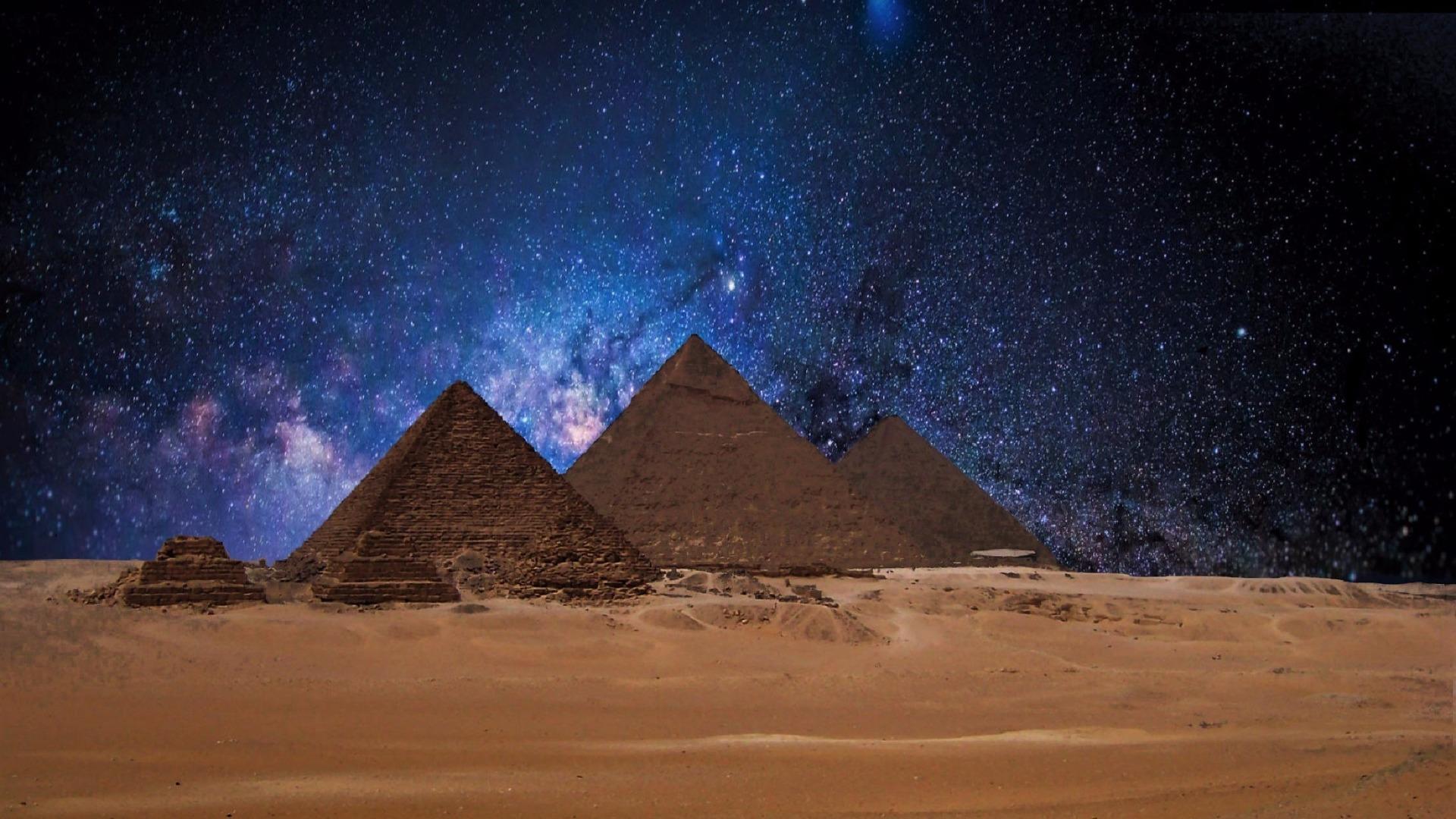The Akh’Barad, which literally translates to “the people of the sand” in the native language of the Akh’Barad, are a group of humans spread across an arid, largely desert stretch of the world that includes the Maghana Deserts. The people of the Akh’Barad are spread within numerous kingdoms and countries that are unified in faith, as well as dispersed in countries where their worship is a minority. Many Akh’Barad worshippers live in nomadic tribes constantly traveling for fresh water and hunting opportunities. Some Akh’Barad, however, have settled into villages and a few great cities along mighty rivers and waterways where the abundant supply of fresh water allows them to establish agricultural-based communities.
There are eleven gods in the Akh’Barad pantheon, but among those who worship the Akh’Barad pantheon, there are numerous different sects with differing emphases in their faith.
In areas where the Akh’Barad faith is the dominant religion, or at least a very prominent one, temples to the gods tend to be made in the form of giant pyramids with a four-sided base. Of course, this is not possible for nomadic tribes, nor for the Akh’Barad diaspora living in areas where members of their faith are few, or where their religion is banned. In these areas, the Akh’Barad will sometimes use obelisks of varying sizes to mark places of worship.
Miniature pyramids are sometimes used as religious iconography, but the triangle, ankh, and shepherd’s crook are commonly used as holy symbols.
Description of the Gods
By God
Fah
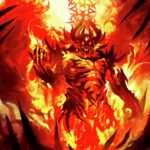 Fah is the god of the Sun and Fire. He appears as the Sun but can also simultaneously appears as 11 other avatars, always as a ball of fire or as a giant humanoid form engulfed in flames. He is considered by most to be the most power god of the Akh’Barad, and some worshippers see him as the only god, with the others as demigods or even just celestials. Some factions of his worshippers believe in spreading the faith through military conquest. At night he descends to the Underworld while Semefet travels the earth collecting fresh souls, and in this underworld realm, Fah determines which souls have done their penance and are ready to be reincarnated again. Domains: Forge, Light, Life, War, Death, Grave, Order, Twilight
Fah is the god of the Sun and Fire. He appears as the Sun but can also simultaneously appears as 11 other avatars, always as a ball of fire or as a giant humanoid form engulfed in flames. He is considered by most to be the most power god of the Akh’Barad, and some worshippers see him as the only god, with the others as demigods or even just celestials. Some factions of his worshippers believe in spreading the faith through military conquest. At night he descends to the Underworld while Semefet travels the earth collecting fresh souls, and in this underworld realm, Fah determines which souls have done their penance and are ready to be reincarnated again. Domains: Forge, Light, Life, War, Death, Grave, Order, Twilight
Akh’Mashnazahd, the Prince of Sand
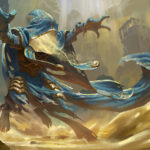 Akh’Mashnazahd rules the sandy deserts, and there are some who consider him to be the true head of the Akh’Barah pantheon. Like Fah, he is sometimes indifferent to the effects his harsh domain has on his worshippers, though many believe it to be a form of “tough love,” that only the strongest are worthy. Akh’Mashnazahd is said to have dozens of demigod sons who are made of pure sand but rise from the dunes in the shapes of men or other creatures to do Akh’Mashnazahd’s bidding. Though his worshippers tend to be nomadic tribes, they travel with and often leave behind tall stone statues generally just of his face. These statues are often seven to ten feet tall, and nomadic tribes will leave them near oases and stone outcroppings to serve as scattered places of worship. Domains: Light, Nature, Tempest
Akh’Mashnazahd rules the sandy deserts, and there are some who consider him to be the true head of the Akh’Barah pantheon. Like Fah, he is sometimes indifferent to the effects his harsh domain has on his worshippers, though many believe it to be a form of “tough love,” that only the strongest are worthy. Akh’Mashnazahd is said to have dozens of demigod sons who are made of pure sand but rise from the dunes in the shapes of men or other creatures to do Akh’Mashnazahd’s bidding. Though his worshippers tend to be nomadic tribes, they travel with and often leave behind tall stone statues generally just of his face. These statues are often seven to ten feet tall, and nomadic tribes will leave them near oases and stone outcroppings to serve as scattered places of worship. Domains: Light, Nature, Tempest
Tabesh
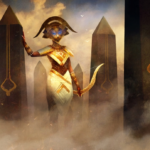 Tabesh is a goddess is depicted as having the face of a black cat and the body of a beautiful woman with ebony skin. She is often depicted seated on an ornate throne, the dispassionate patron of order, law, and governance – but also cunning and diplomatic intrigue. In one tale, her son Dag’Dishe was slain by Zad’Aka, the Scorpion King. She went to the underworld to plead with Semefet for the release of his soul. Though Semefet would not relent, he did allow her to spend some time with his body, whereupon she secretly devoured her son’s heart, brains, and liver. Upon returning to her home, she was able to gestate his consumed remains and from his heart gave birth to him again, while from his brains and liver gave birth to his triplet brothers, Bag’Dishe and Pag’Dishe. Domains: Knowledge, Trickery, Arcana, Order, Peace, Twilight
Tabesh is a goddess is depicted as having the face of a black cat and the body of a beautiful woman with ebony skin. She is often depicted seated on an ornate throne, the dispassionate patron of order, law, and governance – but also cunning and diplomatic intrigue. In one tale, her son Dag’Dishe was slain by Zad’Aka, the Scorpion King. She went to the underworld to plead with Semefet for the release of his soul. Though Semefet would not relent, he did allow her to spend some time with his body, whereupon she secretly devoured her son’s heart, brains, and liver. Upon returning to her home, she was able to gestate his consumed remains and from his heart gave birth to him again, while from his brains and liver gave birth to his triplet brothers, Bag’Dishe and Pag’Dishe. Domains: Knowledge, Trickery, Arcana, Order, Peace, Twilight
Laba Dishe, or the Brothers Dishe
 Dag’Dishe was the son of Tabesh and a warrior king, known for his battle prowess, honor, and pride. In one legend, Dag’Dishe came across Zad’Aka, the Scorpion King, and engaged him in battle. Dag’Dishe was slain in the battle (some say through treachery or poison, though others note that Dag’Dishe initiated the battle without provocation and the Scorpion King was fighting for his life). The Scorpion King took Dag’Dishe’s body to his one of his palaces, which happened to be in Semefet’s realm in the Underworld, until Semefet forced him to turn it over. Tabesh then traveled to the Underworld where she begged Semefet to release Dag’Dishe’s body and soul and let him live again. Semefet refused but did allow her time to grieve over Dag’Dishe’s body. While she was alone with his body, Tabesh secretly ate Dag’Dishe’s heart, brains, and liver. Back home, she used her magic to gestate his organs. From his heart, Dag’Dishe was reborn – as an infant, but with Dag’Dishe’s memory and personality intact as he grew older. From the brains grew his brother Bag’Dishe, who was wiser and scholarly, more sensitive, and more cautious and prudent than Dag’Dishe. He had memories of Dag’Dishe’s original life but from his rebirth forward was separate with his own thoughts and feelings. From the liver was born a third brother, Pag’Dishe, who embraced the arts, music, and had a great joy of life.
Dag’Dishe was the son of Tabesh and a warrior king, known for his battle prowess, honor, and pride. In one legend, Dag’Dishe came across Zad’Aka, the Scorpion King, and engaged him in battle. Dag’Dishe was slain in the battle (some say through treachery or poison, though others note that Dag’Dishe initiated the battle without provocation and the Scorpion King was fighting for his life). The Scorpion King took Dag’Dishe’s body to his one of his palaces, which happened to be in Semefet’s realm in the Underworld, until Semefet forced him to turn it over. Tabesh then traveled to the Underworld where she begged Semefet to release Dag’Dishe’s body and soul and let him live again. Semefet refused but did allow her time to grieve over Dag’Dishe’s body. While she was alone with his body, Tabesh secretly ate Dag’Dishe’s heart, brains, and liver. Back home, she used her magic to gestate his organs. From his heart, Dag’Dishe was reborn – as an infant, but with Dag’Dishe’s memory and personality intact as he grew older. From the brains grew his brother Bag’Dishe, who was wiser and scholarly, more sensitive, and more cautious and prudent than Dag’Dishe. He had memories of Dag’Dishe’s original life but from his rebirth forward was separate with his own thoughts and feelings. From the liver was born a third brother, Pag’Dishe, who embraced the arts, music, and had a great joy of life.
They are known collectively as the Laba Dishe, the Brothers Dishe, and together represent the balance of all things in life.
Dag’Dishe
Dag’Dishe was the son of Tabesh from whom was born the Laba Dishe, the Brothers Dishe. He is a warrior, the personification of strength, battle prowess, chivalry, and honor. Legend says that one day he engaged Zad’Aka, the Scorpion King, in battle. Zad’Aka slew him and took his remains to one of his palaces in the underworld. Semefet eventually demanded that Zad’Aka turn over Dag’Dishe’s body, and when this happened, Tabesh journeyed to the underworld to beg for her son’s body and soul to be returned. Semefet refused but gave her time alone to mourn over his body. Tabesh secretly devoured Dag’Dishe’s heart, brains, and liver, and then caused those parts to gestate once she returned to her own realm. Dag’Dishe was reborn from his heart, while his brother Bag’Dishe was reborn from his brain and Pag’Dishe was reborn from his liver. Dag’Dishe represents knighthood and chivalry, the pinnacle of strength, courage, and honor. He represents being present in the moment. Domains: War, Order, Tempest
Bag’Dishe
Bag’Dishe was born of his brother Dag’Dishe's heart after their mother, Tabesh, was forced to consume Dag’Dishe’s organs in their underworld. His other brother, Pag’Dishe, was born of Dag’Dishe’s liver. Of the triplets, Bag’Dishe is the most sensitive, wise, and scholarly. He is temperate, cautious, and prudent, and represents forward-thinking and planning for the future. Domains: Knowledge, Arcana
Pag’Dishe
Pag’Dishe is the brother of Dag’Dishe who was born of his liver when their mother rescued Dag’Dishe’s organs from the Underworld, just as their third brother, Bag’Dishe, was born of Dag’Dishe’s brains. Pag’Dishe has the greatest zest for life of the three brothers and the strongest appreciation for the arts, music, fine food and wine, humor and harmless pranks, and other hedonistic delights. Domains: Life, Peace, Trickery, Twilight
Semefet, Prince of the Night
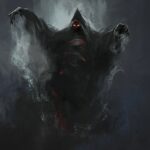 Semefet, Prince of the Night, sometimes called the Prince of Darkness, is the Lord of the Underworld. He is rarely referred to by name and is generally known by his epithets of the Prince of the Night or the Prince of Darkness. He is depicted as a silent man, hooded in a dark cloak and wreathed in shadows. By day, he resides in the Underworld and rules over the spirits of the mortal dead. By night, he silently and invisibly sweeps about the earth collecting souls of the recently passed while Fah takes his place in the Underworld, sitting in judgement of the souls to determine which are ready to be reincarnated. Domains: Death
Semefet, Prince of the Night, sometimes called the Prince of Darkness, is the Lord of the Underworld. He is rarely referred to by name and is generally known by his epithets of the Prince of the Night or the Prince of Darkness. He is depicted as a silent man, hooded in a dark cloak and wreathed in shadows. By day, he resides in the Underworld and rules over the spirits of the mortal dead. By night, he silently and invisibly sweeps about the earth collecting souls of the recently passed while Fah takes his place in the Underworld, sitting in judgement of the souls to determine which are ready to be reincarnated. Domains: Death
Vak’Shana, the Lady of the Flood
 Vak’Shana, the Goddess of Spring, is also known as the Lady of the Flood, as it is believed that she controls the spring floods that are vital for agriculture in the arid realms of the Akh’Barad. Her worship is heaviest near the few great rivers where spring floods from winter snowmelt provides nutrient-rich silt for the fields that will then be planted with agricultural crops in the spring. Times of drought with low snowfall and little flooding result in a poor harvest season and, ultimately, famine. The Akh’Barad pray to Vak’Shana to spare them during these trying times. Domains: Life, Nature, Tempest
Vak’Shana, the Goddess of Spring, is also known as the Lady of the Flood, as it is believed that she controls the spring floods that are vital for agriculture in the arid realms of the Akh’Barad. Her worship is heaviest near the few great rivers where spring floods from winter snowmelt provides nutrient-rich silt for the fields that will then be planted with agricultural crops in the spring. Times of drought with low snowfall and little flooding result in a poor harvest season and, ultimately, famine. The Akh’Barad pray to Vak’Shana to spare them during these trying times. Domains: Life, Nature, Tempest
Jemar Hez’Azkabah, Lord of Justice
 Jemar Hez’Azkabah was a mortal man, the thirteenth child of a peasant family who turned their son to the temples to raise him to become a monk or priest, as they could not afford to care for him. He became an adept clerk and was eventually assigned to a great Raja’s granaries. His accurate accounting and forecasting eventually brought him to the Raja’s attention and he was brought within the palace to manage the Raja’s own accounts. During the Peasant Revolt, one of the complaints was the inconsistent application of laws. With the Raja’s consent, Jemar Hez’Azkabah compiled two great books. The first was a record of all of the statutes and edicts, the first written codification of laws of the Akh’Barad. The second was a set of standards of criminal procedure so that all people arrested, regardless of their rank or stature, or their friendships with those in power, would be treated the same in the criminal courts. This made him enormously popular with the people and the Raja made Jemar his Grand Vizier, but it also made Jemar acquire powerful enemies among the Raja’s warlords. On an outing with the Raja, the warlords attempted to assassinate Jemar by poison. Though wracked with pain, he did not die. For three days he writhed in agony until a priest of Fah prayed for his release and a bolt of lightning from a cloudless sky struck Jemar and ignited the poison in his veins. Jemar burned from within, floating into the air while screaming in agony. Then suddenly, though still burning from within, he grew calm. Still floating in the air, he called out the names of the men who had poisoned him, and the names of the others who had secretly conspired with them. He called out their other secrets, too – their crimes and misdeeds, their affairs and predilections, even their dark fantasies that they had never spoken aloud. And he called out the more serious crimes of others present, too, though not their more private secrets. And when he was done, his body was fully engulfed in flames and crumbled into ash. The Raja carefully scooped Jemar’s ashes into a wooden box and built a great temple in Jemar’s honor. It was said that Fah himself elevated Jemar Hez’Azkabah to the level of godhood, and the people prayed to him. It was said that within temples to his honor, no one can knowingly utter a falsehood, and his temples are often also used as courthouses. He became a patron of the people, particularly in the equitable application of laws, but also in particular of the courts. Domains: Order, Arcana, Knowledge, Light, Peace, Tempest, Twilight
Jemar Hez’Azkabah was a mortal man, the thirteenth child of a peasant family who turned their son to the temples to raise him to become a monk or priest, as they could not afford to care for him. He became an adept clerk and was eventually assigned to a great Raja’s granaries. His accurate accounting and forecasting eventually brought him to the Raja’s attention and he was brought within the palace to manage the Raja’s own accounts. During the Peasant Revolt, one of the complaints was the inconsistent application of laws. With the Raja’s consent, Jemar Hez’Azkabah compiled two great books. The first was a record of all of the statutes and edicts, the first written codification of laws of the Akh’Barad. The second was a set of standards of criminal procedure so that all people arrested, regardless of their rank or stature, or their friendships with those in power, would be treated the same in the criminal courts. This made him enormously popular with the people and the Raja made Jemar his Grand Vizier, but it also made Jemar acquire powerful enemies among the Raja’s warlords. On an outing with the Raja, the warlords attempted to assassinate Jemar by poison. Though wracked with pain, he did not die. For three days he writhed in agony until a priest of Fah prayed for his release and a bolt of lightning from a cloudless sky struck Jemar and ignited the poison in his veins. Jemar burned from within, floating into the air while screaming in agony. Then suddenly, though still burning from within, he grew calm. Still floating in the air, he called out the names of the men who had poisoned him, and the names of the others who had secretly conspired with them. He called out their other secrets, too – their crimes and misdeeds, their affairs and predilections, even their dark fantasies that they had never spoken aloud. And he called out the more serious crimes of others present, too, though not their more private secrets. And when he was done, his body was fully engulfed in flames and crumbled into ash. The Raja carefully scooped Jemar’s ashes into a wooden box and built a great temple in Jemar’s honor. It was said that Fah himself elevated Jemar Hez’Azkabah to the level of godhood, and the people prayed to him. It was said that within temples to his honor, no one can knowingly utter a falsehood, and his temples are often also used as courthouses. He became a patron of the people, particularly in the equitable application of laws, but also in particular of the courts. Domains: Order, Arcana, Knowledge, Light, Peace, Tempest, Twilight
Zad’Aka, the Scorpion King
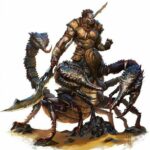 Zad’Aka is depicted as a seven-foot-tall man with a scorpion tail and the ability to turn his hands into scorpion pincers at will. He rides a giant scorpion that’s the size of an elephant and can conjure an army of scorpions the size of hounds at will. He has a lavish palace that appears to have no fixed location and can sometimes be found in the middle of the sandy deserts, at the top of mountain peaks, beneath the ocean, or in Semefet’s realm in the Underdark. He famously slew Dag’Dishe in combat, and it was only Tabesh’s guile that allowed her son to come back to life, along with his unexpected triplet siblings. Zad’Aka is wed to Ej’Antlahan, the Adder Queen. He is a patron of combat, particularly of bandits, ruffians, and mercenaries, and his worship is largely confined to underground cults and secretive sects. Domains: War; Death
Zad’Aka is depicted as a seven-foot-tall man with a scorpion tail and the ability to turn his hands into scorpion pincers at will. He rides a giant scorpion that’s the size of an elephant and can conjure an army of scorpions the size of hounds at will. He has a lavish palace that appears to have no fixed location and can sometimes be found in the middle of the sandy deserts, at the top of mountain peaks, beneath the ocean, or in Semefet’s realm in the Underdark. He famously slew Dag’Dishe in combat, and it was only Tabesh’s guile that allowed her son to come back to life, along with his unexpected triplet siblings. Zad’Aka is wed to Ej’Antlahan, the Adder Queen. He is a patron of combat, particularly of bandits, ruffians, and mercenaries, and his worship is largely confined to underground cults and secretive sects. Domains: War; Death
Ej’Antlahan, the Adder Queen
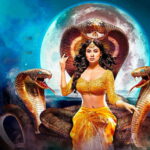 Ej’Antlahan, the Adder Queen, is depicted as a seven-foot-tall woman with reptilian eyes, venomous fangs, and the ability to transform herself at will to any sort of human/serpent hybrid. In her morphed forms, she is sometimes depicted as a human woman with the head of a cobra, or as having the head, arms, and upper torso of a woman descending into a serpentine lower body. She is depicted as sly, conniving, and duplicitous, the patron of spies and assassins. Her worship is banned, even more so than that of her consort, Zad’Aka, and is her priests will only be found in secretive cults. Even so, those desperate enough to hire assassins for the most dangerous missions will often seek out her priests, who work with their own network of assassins and provide their own special blessings for them. Domains: Trickery, Death, Arcana
Ej’Antlahan, the Adder Queen, is depicted as a seven-foot-tall woman with reptilian eyes, venomous fangs, and the ability to transform herself at will to any sort of human/serpent hybrid. In her morphed forms, she is sometimes depicted as a human woman with the head of a cobra, or as having the head, arms, and upper torso of a woman descending into a serpentine lower body. She is depicted as sly, conniving, and duplicitous, the patron of spies and assassins. Her worship is banned, even more so than that of her consort, Zad’Aka, and is her priests will only be found in secretive cults. Even so, those desperate enough to hire assassins for the most dangerous missions will often seek out her priests, who work with their own network of assassins and provide their own special blessings for them. Domains: Trickery, Death, Arcana
Gods by Domain
- Arcana – Tabesh; Bag’Dishe; Jemar Hez’Azkabah; Ej’Antlahan
- Death – Semefet; Ej’Antlahan; Zad’Aka; Fah
- Forge – Fah
- Grave – Pag’Dishe; Fah
- Knowledge – Tabesh; Bag’Dishe; Jemar Hez’Azkabah
- Life – Fah; Pag’Dishe; Vak’Shana
- Light – Akh’Mashnazahd; Fah; Jemar Hez’Azkabah
- Nature – Akh’Mashnazahd; Vak’Shana
- Order – Jemar Hez’Azkabah; Tabesh; Fah; Dag’Dishe
- Peace – Jemar Hez’Azkabah; Tabesh; Pag’Dishe
- Tempest – Akh’Mashnazahd; Vak’Shana; Jemar Hez’Azkabah, Dag’Dishe
- Trickery – Tabesh; Ej’Antlahan; Pag’Dishe
- Twilight – Tabesh; Fah; Jemar Hez’Azkabah; Pag’Dishe
- War – Fah; Dag’Dishe; Zad’Aka
Demigods of the Akh’Barad
The Akh’Barad believe that on rare occasions, the mightiest of human heroes may be elevated to a form of demigod status upon their deaths – divine creatures that might be called “saints” in other religions. They manifest in the heavens as powerful celestials: devas, planetars, solars, or most rarely, empyreans.
The Akh’Barad include these demigods in their worship, believing that the demigods, while unable to grant divine power to divine priests, can occasionally intercede with the gods on the worshipper’s behalf. Jemar Hez’Azkabah is the only example in the Akh’Barad faith of a human being elevated directly to godhood rather than demigod status. Some Akh’Barad, particularly of the Fah’Barad and Fah’Barad Hai sects, believe any worship of Jemar Hez’Azkabah as anything more than a demigod to be heretical.
On rare occasions, these demigods may enter into a pact with mortal warlocks, but many Akh’Barad clerics believe these warlocks to be heretics for deriving their powers from demigods rather than the gods themselves.
Akh’Barad Sects
The Akh’Barad faith is practiced differently in many different sects that treat the gods somewhat different. Of these, Akh'Barad Turu is the most common sect, though even it has more than half a dozen variations. The sect of Fah’Barad Hai is the most militant, while the Akh’Mashnazahd’Barad sect claims to worship in the manner closest to the origins of the Akh’Barad.
Akh’Barad Turu
The Akh'Barad Turu, which roughly translates to the “Universal People of the Sand,” is the most common and widespread form of the faith. It’s a term used more by religious scholars and observers than the worshippers themselves, who simply call themselves the Akh’Barad. In this form of the religion, the entire pantheon is worshipped equally. While some consider Akh’Mashnazahd to be the most powerful deity of the pantheon, most consider Fah, the Sun God, to be the most powerful of the gods, but the point isn’t particularly relevant. All of the gods are worshipped together, all are given special deference on their feast days and holidays, and the entire pantheon is collectively respected. Individual tribes and villages may adopt one of the gods as their particular patron, but they nevertheless will have shrines or temples for the other gods and will continue to pay homage and respect to all of the other gods on their feast days. When a village or tribe has adopted a particular god as their patron, their faith is known as the Akh’Barad ni’Fa, or Akh’Barad ni’Akh’Mashnazahd, or the like, meaning “People of the Sand Under the Protection of Fa,” or “…Under the Protection of Akh’Mashnazahd,” and so forth.
Akh’Barad ni’Fa
Akh’Barad ni’Fa literally translates to “People of the Sand Under the Protection of Fa.” It is an Akh'Barad Turu sect that recognizes and worships the entire pantheon of Akh’Barad gods, but who have adopted Fah as their personal patron and protector for their village or community.
Akh’Barad ni’Akh’Mashnazahd
Akh’Barad ni’Akh’Mashnazahd literally translates to “People of the Sand Under the Protection of Akh’Mashnazahd.” It is an Akh'Barad Turu sect that recognizes and worships the entire pantheon of Akh’Barad gods, but who have adopted Akh’Mashnazahd as their personal patron and protector for their village or community.
Akh’Barad ni’Tabesh
Akh’Barad ni’Tabesh literally translates to “People of the Sand Under the Protection of Tabesh.” An Akh'Barad Turu sect that recognizes and worships the entire pantheon of Akh’Barad gods, but who have adopted Tabesh as their personal patron and protector for their village or community.
Akh’Barad ni’DagDishe
Akh’Barad ni’DagDishe translates to “People of the Sand Under the Protection of Dag’Dishe.” It is an Akh'Barad Turu sect that recognizes and worships the entire pantheon of Akh’Barad gods, but who have adopted Dag’Dishe as their personal patron and protector for their village or community.
Akh’Barad ni’BagDishe
Akh’Barad ni’BagDishe translates to “People of the Sand Under the Protection of Bag’Dishe.” It is an Akh'Barad Turu sect that recognizes and worships the entire pantheon of Akh’Barad gods, but who have adopted Bag’Dishe as their personal patron and protector for their village or community.
Akh’Barad ni’PagDishe
Akh’Barad ni’PagDishe translates to “People of the Sand Under the Protection of Pag’Dishe.” It is an Akh'Barad Turu sect that recognizes and worships the entire pantheon of Akh’Barad gods, but who have adopted Dag’Pishe as their personal patron and protector for their village or community.
Akh’Barad ni’Vak’Shana
Akh’Barad ni’Vak’Shana translates to “People of the Sand Under the Protection of Vak’Shana.” An Akh'Barad Turu sect that recognizes and worships the entire pantheon of Akh’Barad gods, but who have adopted Vak’Shana as their personal patron and protector for their village or community.
Akh’Barad ni’Jemar
Akh’Barad ni’Jemar translates to “People of the Sand Under the Protection of Jemar Hez’Azkabah.” It is an Akh'Barad Turu sect that recognizes and worships the entire pantheon of Akh’Barad gods, but who have adopted Jemar Hez’Azkabah as their personal patron and protector for their village or community.
Akh’Mashnazahd’Barad
Though Fah, God of the Sun and Fire, has achieved dominance as the most powerful deity in the Akh’Barad pantheon, there was a time when Akh’Mashnazahd, the Prince of Sand, held sway. There are still some areas of the faith that consider him to be the most powerful. While most of the tribes who live on or near the great sandy dunes of the Maghana Deserts would be considered of the Akh'Barad Turu faith with Akh’Mashnazahd as their particular patron (Akh’Barad ni’Akh’Mashnazahd), there are some tribes who still worship an older faith with Akh’Mashnazahd as the most powerful god, the only Greater God, with Fah and the other gods as Lesser Gods. This sect is known as the Akh’Mashnazahd’Barad. Fah’s most devout supporters believe that practitioners of the Akh’Mashnazahd’Barad sect are heretics.
Urgdard uk Laba Dishe
The sect known as the Urgdard uk Laba Dishe (“the balance of the Brothers Dishe”), or sometimes for short the Laba Dishe (“the Brothers Dishe”) or simply the Urgdard (“the Balance”) usually operates as a peaceful sect within communities of the Akh’Barad, generally openly and unmolested. Unlike the sects of Akh’Barad ni’DagDishe, Akh’Barad ni’BagDishe, and Akh’Barad ni’PagDishe, the worshippers of Urgdard uk Laba Dishe venerate the three triplet sons of Tabesh together as a trinity. Dag’Dishe represents strength, loyalty, honor, hard work, physical prowess, and attention to the task at hand. Bag’Dishe represents knowledge, education, prudence, and striving for improvement. Pag’Dishe represents the enjoying the pleasures and joys of life, appreciating the fruits of one’s labors, remembering to “smell the flowers.” Taken as a whole, the sect is about finding balance in all things in life.
Tabesh’Barad
The Tabesh’Barad, or the People of Tabesh, are a sect who have placed the goddess Tabesh at the head of the Akh’Barad pantheon. This goes beyond those Akh'Barad Turu communities that have adopted Tabesh as their patron and protector. In the Tabesh’Barad sect, the religious practice is matriarchal, and the goddess Tabesh is seen as providing wisdom and guidance, particularly for government officials. While many rulers and warlords recognize Tabesh and Jemar Hez’Azkabah as having a special role among the gods for political leadership, only in a few purely matriarchal Akh’Barad cultures is the Tabesh’Barad sect the primary faith. Even so, many larger cities will have all-female monasteries devoted to the Tabesh’Barad sect, and some of their novitiates will often serve as handmaidens for the Maharaja’s or Warlords’ wives. Some of the more patriarchal-dominated and misogynistic areas of the Akh'Barad Turu have discouraged and suppressed the Tabesh’Barad, and even outright banned the sect.
Fah’Barad
While a majority of the Akh’Barad worship as part of the broader Akh'Barad Turu faith, believing in the balance of all of the gods, many believe Fah rather than Akh’Mashnazahd to be the most preeminent of the gods. This is not necessarily inconsistent with Akh'Barad Turu teachings, providing that proper respect and worship of the other gods is provided on their feast days. But those who follow the Fah’Barad sect believe that Fah is the only Greater God and all of the others are Lesser Gods. In communities where they have taken control, they may tolerate other sects to varying degrees providing that proper respect is granted to Fah and that only those who are part of the Fah’Barad sect can hold positions of political power. But among the more militant and monotheistic Fah’Barad Hai offshoot sect, Fah is considered to be the only god, and the others are considered to be mere demigods, like celestials or saints. In these communities, open worship of the other gods is forbidden; prayers to those gods are permitted only as a plea for them to intercede with Fah. The Fah’Barad Hai will either convert the temples of other gods to be a temple to Fah or will completely destroy them unless they are no more than a small shrine, and they will slay without trial any high-ranking priest of any of the other gods who does not convert to becoming a priest of Fah. It is an incredibly patriarchal cult, and priestesses of Tabesh are particularly vulnerable, as are any worshippers of the Tabesh’Barad sect.
Fah’Barad Hai
Fah’Barad Hai is a militant and monotheistic offshoot of the Fah’Barad sect. In this sect, adherents believe that Fah is the only god, and the other gods of the Akh’Barad pantheon are no more than mere demigods, like celestials or saints. In these communities, open worship of the other gods is forbidden; prayers to those gods are permitted only as a plea for them to intercede with Fah. The Fah’Barad Hai will either convert the temples of other gods to be a temple to Fah or will completely destroy them unless they are no more than a small shrine, and they will slay without trial any high-ranking priest of any of the other gods who does not convert to becoming a priest of Fah. It is an incredibly patriarchal cult, and priestesses of Tabesh are particularly vulnerable, as are any worshippers of the Tabesh’Barad sect.


